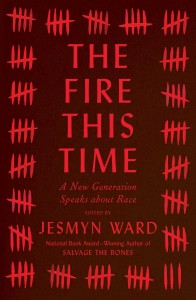
This collection of essays and poems, subtitled A New Generation Speaks about Race, together provides a nuanced portrait of racism and race in the U.S. today. It is divided into three parts: Legacy, Reckoning and Jubilee—past, present and future.
Ward, who collected the pieces, supplies the introduction and a piece on what she learned from DNA testing, noting how hard it is for people to discover the genealogy of the black side of their family. Two pieces look at the legacy of black writers, Rachel Ghansah comparing her grandfather’s life to James Baldwin’s and Honorèe Jeffers questioning Phillis Wheatley’s history as it is presented to us.
The book’s title is a play on Baldwin’s The Fire Next Time, which in turn takes its title from an old spiritual: “God gave Noah the rainbow sign / No more water, the fire next time.”
Some pieces convey personal experiences, such as Garnette Cadogan’s essay comparing his experiences walking in his native Kingston, Jamaica with walking the streets of New Orleans and later those of New York. Never having been given “The Talk,” he had to work out for himself how to camouflage himself—preppie clothes and his college sweatshirt; never a hoodie or jeans and tee shirt—and the rules to follow to keep white people from being afraid of him or police from stopping him.
Many of the pieces respond to the relentless killing of black people by police and armed vigilantes, such as Claudia Rankin’s “The Condition of Black Life Is One of Mourning” and Isabel Wilkerson’s “Where Do We Go from Here?” Emily Raboteau describes going with her family to see the recently reopened High Bridge in New York City that connects Harlem and the Bronx. There she discovers a mural that leads her on a tour of discovery around the city to find all the murals that, combining love and activism, educate adults and children on how to protect themselves from police brutality and structural racism.
I was especially intrigued by Kevin Young’s funny and piercing “Blacker Than Thou” where he talks about white people wearing blackface or actually “passing” as black, such as Rachel Dolezal. “But if you are white but truly feel black, then why do you have to look like it?” Blackness, he says, is not about skin color but about culture. He says of black people, “Any solidarity with each other is about something shared, a secret joy, a song, not about some stereotypical qualities that may be reproducible, imitable, even marketable.”
Of Dolezal, he says, “She wears the mask not to hide but to gain authority over the very thing she claims she wants to be.” Her claim is of a piece with her other stories that paint her as a victim. And, as with blackface and other examples of passing, it says more about how those white people view blackness.
Poems by Jericho Brown, Kima Jones, Clint Smith add texture and imagery, always a more intense experience for me. And I loved seeing Natasha Tretheway’s familiar “Theories of Time and Space” opening the Jubilee section.
I learned a lot from this cornucopia of voices. I still have a lot to learn.
What have you read lately that made you cry and laugh and thunder with rage, and most of all made you think?